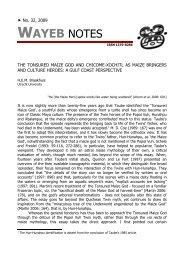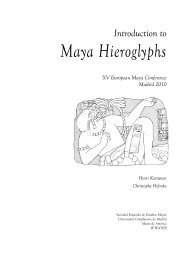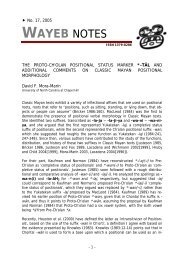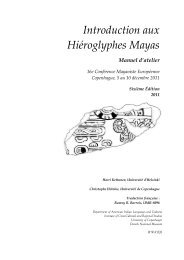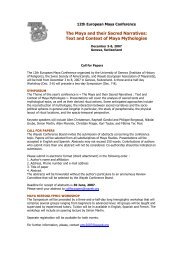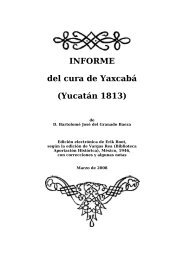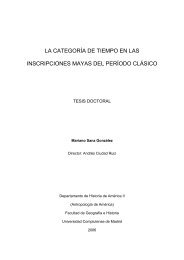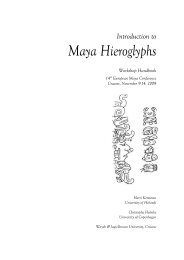Introduction to Maya Hieroglyphs - Wayeb
Introduction to Maya Hieroglyphs - Wayeb
Introduction to Maya Hieroglyphs - Wayeb
Create successful ePaper yourself
Turn your PDF publications into a flip-book with our unique Google optimized e-Paper software.
Kettunen & Helmke 2011<br />
Appendices<br />
A SHORTCUT GUIDE FOR THE CONVERSION OF<br />
MAYA LONG COUNT DATES TO GREGORIAN DATES 56<br />
(for <strong>Maya</strong> date 9.15.6.14.6)<br />
A rough estimate of a Gregorian date can be achieved by adding <strong>to</strong>gether the “bak’tuns” (9), “k’atuns” (15),<br />
“tuns” (6), “winals” (14), and “k’ins” (6) (=1 406 446), dividing the result by 365 (number of days in a year) (≈3<br />
853,28) and subtracting 3115 (the beginning of the <strong>Maya</strong> calendar in year 3114 + year zero) from it (=AD738).<br />
A more accurate approximation can be achieved by using the following formula: 57<br />
(M / 365.25) – 3112.31 = Y<br />
In this formula M is computed by adding the “bak’tuns”, “k’atuns”, “tuns”, “winals”, and “k’ins” (as above), and<br />
Y will be the year and the fraction of year (approximately).<br />
Figure 27: Codex style vase from the Late Classic Period<br />
(pho<strong>to</strong>: Harri Kettunen; courtesy of Kimbell Art Museum)<br />
56<br />
The calculation below offers a ±1 year rough estimate of a given Long Count date <strong>to</strong> be utilized in working out the overall time period of a given<br />
monument (if knowing the precise Gregorian date is not essential in that particular context).<br />
57<br />
We would like <strong>to</strong> thank Mark Matney from the NASA Johnson Space Center in Hous<strong>to</strong>n for providing us this formula in 2009.<br />
54/154



